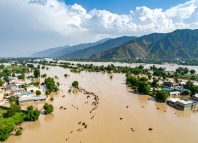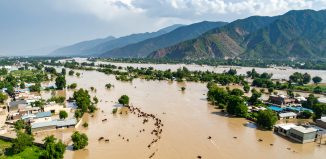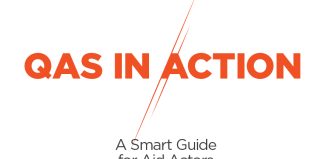Situation Update: More Rains Prediction to further intensify the flood damages Across Pakistan
The monsoon rains that struck Pakistan in the third week of July are still continuing across the country. As a result of the heavy monsoon rains and melting of glaciers in the north of country, there has been widespread flooding in different regions of the country. The table below shows the level of damages reported till today:
| No. of Casualties | People injured | Houses damaged | Villages affected | Total affected population |
| 146 | 66 | 3,133 | 2,073 | 752,274 |
The floods have also severely damaged the infrastructure and local livelihoods of many parts of rural and semi-urban Pakistan; agricultural fields and crops have been damaged. A number of local markets, link roads, connecting bridges and micro-hydro power stations have been reported damaged as well.
As per the latest reports of the Pakistan Meteorological & Hydrological Department, the River Indus at Guddu Barrage is likely to attain a High to very High flood level ranging between 650,000 cusecs to 750,000 cusecs during 1400 PST of August 1st to 2400 PST of August 3rd 2015. It was further added that the flood levels will continue to remain high for the following seven days.
River Indus at Sukkur is also reported to maintain a High to very High flood level ranging between 650,000 cusecs to 750,000 cusecs during 1200 PST of August 2nd to 2400PST of August 4th2015. Flood levels will remain high for the next seven days in this region as well.
Unceasing heavy monsoon showers are expected in the coming days across Pakistan and a further increase in the water levels in Kabul, Indus, Jhelum and Chenab Rivers may intensify the flooding in Sindh. The Director General of the Meteorological Department still maintains as per his earlier message that India is also likely to release excess water from its dams in the following days which can upsurge flooding in the low-lying areas of Pakistan also. The authorities have warned of massive destruction in interior Sindh in the subsequent weeks as flood water from all of over the country will pass through catchment districts of Indus River in the Southern province.
The impact of the latest flash floods on different provinces of Pakistan are indicated briefly below:
| SINDH | ||||
| No. of Casualties | People injured | Houses Damaged | Villages Affected | Total affected population |
| 16 | -* | -* | 1,423 | 281, 921 |
| * No definite number available yetThe affected communities displaced are forced to live in tents and under the open sky or on embankments and elevated places in the affected districts. The government has established relief camps at various embankments for the affected people however people have been reported to prefer to live in open spaces instead. The provincial government together with the Pakistan Army is providing rescue and evacuation services to the flood affected communities and villages. | ||||
| KHYBER PAKHTUNKHWA (KPK) | ||||
| No. of Casualties | People injured | Houses Damaged | Villages Affected | Total affected population |
| 73 | 31 | 348 | 292 | -* |
| * No definite number available yetChitral is the worst affected district in KPK province. Majority of the villages have lost land-connections that they had between major cities as link roads and connecting bridges, micro-hydro power stations have been severely damaged. The Government has distributed relief items including tents among the displaced families and has also announced a cash compensation of PKR. 0.5 Million for each affected family that has lost their house in the floods in Chitral. | ||||
| GILGIT BALTISTAN | ||||
| No. of Casualties | People injured | Houses Damaged | Villages Affected | Total affected population |
| 5 | 2 | 653 | 175 | 136,000 |
| * No definite number available yetGhizar, Astor, Skardu and Hunza districts have been reported to be severely damaged. A number of roads and connecting bridges have been washed away that has left many villages disconnected from the main towns. | ||||
| Azad Jammu and Kashmir (AJK) | ||||
| No. of Casualties | People injured | Houses Damaged | Villages Affected | Total affected population |
| 20 | 8 | 189 | -* | -* |
| * No definite number available yetDistrict Sudhnoti, Neelam, Havaili and Bhimber have been reported to affect by the rains and flash floods. | ||||
| Punjab | ||||
| No. of Casualties | People injured | Houses Damaged | Villages Affected | Total affected population |
| 22 | 4 | 553 | 466 | 334, 353 |
| Villages in Mianwali, Layyah, DG Khan, Rajanpur, Rahimyarkhan and Muzaffargarh districts are most severely swamped by the flood water of River Sindh. Out of the total affected population in Punjab, 59250 are reported to be living in 27 relief camps established by the Government. Crop fields spread across 233,688 acres of land have been totally destroyed. | ||||
| Baluchistan | ||||
| No. of Casualties | People injured | Houses Damaged | Villages Affected | Total affected population |
| 10 | 24 | 620 | -* | -* |
| * No definite number available yetHeavy rainfall, windstorms has affected Districts Zhob, Kohlu and Dera Bugti with flooding. Flood protection walls, electricity poles and links roads have been damaged while trees and plants have been uprooted as well. High flood levels in Guddu and Taunsa barrages are posing a probable threat to more districts of Baluchistan. | ||||
| Federally Administered Tribal Areas (FATA) |
| A number of villages and houses have been reported to be damaged in Khyber and Mohamand agencies of Federally Administered Tribal Areas. However, exact figures have yet to be reported by the authorities and national media. |
Response by Community World Service Asia: Community World Service Asia’s Disaster Response Team are present in KPK, Sindh and Punjab provinces as well as in Azad Jammu & Kashmir. Sindh, positioned on the tail-end of Indus River, is one of the most flood-prone provinces. A number of districts in Sindh are already severely affected and thousands of people are in dire need of immediate food, NFI and health assistance. Community World Service Asia has been able to assist 100 most vulnerable flood affected families in district Ghotki with provision of one month food rations. One month food ration among another 827 families will be distributed in the coming weeks.
Contacts:
Allan A. Calma
Deputy Director
Disaster Management Program
Email: allan.calma@communityworldservice.asia
Cell: +92 301 5801621
Muhammad Fazal
Associate Director
Emergencies/DRR/Climate Change
Email: fazil.sardar@communitryworldservice.asia
Cell: +92 332 5586134
Palwashay Arbab
Head of Communications
Email: palwashay.arbab@communityworldservice.asia
Cell: +92 42 3586 5338
Sources:
www.ndma.gov.pk
www.pdma.gov.pk
www.tribune.com.pk
www.dailytimes.com.pk
www.express.com.pk







